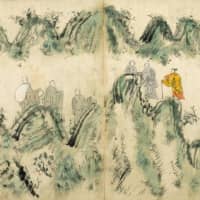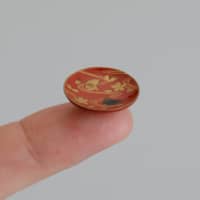Beauty is all around us. Whether it be vibrant, intricately designed attire or elegant tableware, the objects that surround us color the canvas of our daily lives. Since its opening in 1961, the Suntory Museum of Art has organized exhibitions that highlight the relationship between Japanese antiques and everyday life, encouraging visitors to discover the wonders of classic Japanese aesthetics.
The museum’s latest exhibition, “Japanese Art: Deep and Deeper,” which runs through Nov. 29, invites visitors to explore the rich cultural expressions hidden away in the innermost depths of Japanese art. The exhibition is organized into six sections, each centered on a specific theme.
The first section focuses on the concept of space, particularly in relation to paintings. The featured paintings, including the 18th-century painting “Green Maple and Waterfall” by Maruyama Okyo, embellish rooms with new imaginative spaces, completely transforming the atmosphere of their surroundings. This painting features a waterfall vigorously descending from the top of the piece into busy waters below, at the center of which is a black rock standing defiantly still among the white-crested waves that wash over it.
Japan’s adoration of all things miniature can be traced to an observation made by Sei Shonagon in the 10th to 11th-century book, “The Pillow Book,” in which she famously comments on the beauty of all small things. With the advent of traditional Japanese dolls in the Edo Period (1603 to 1868), some craftsman started producing miniature furnishings to accompany the dolls, which were commonly modeled after members of the imperial court, warriors and heroes.
The exhibition features a section dedicated to these objects that range from stationery to tableware and cosmetic tools. The intricate details and elegant design of the miniatures are the result of the significant attention to detail of their artisans, who sold their works to lords and wealthy residents.
Many artists have risen to prominence through their sheer technical prowess. There are others, however, who, despite lacking technical proficiency, capture the hearts of viewers with their artistry’s sincerity. The artists behind the works featured in the third section of the exhibition, which focuses on illustrated tales, are of the latter category. For hundreds of years people have appreciated the unique styles of these unforgettable works. The illustrations of “Karukaya,” folding books from the 16th century that tell the story of a man who leaves his family to enter Buddhist priesthood, captivates with its uninhibited brush strokes and fantastical presentation.
Japan has one of the oldest ceramic traditions in the world, with earthenware production beginning as early as 10,000 B.C., and the bowls and jars produced in kilns across the country have been intertwined with daily life throughout the ages. The pieces on display at this exhibition were produced between the 14th and 18th centuries and feature the natural spontaneity of Japanese aesthetics. The drops of glaze that drip down the sides of these pieces reveal different visual expressions depending on the angle from which they are viewed.
The “Vase in Traveller’s Pillow Shape,” the shape of which is associated with simple pillows used when traveling during the Muromachi Period (1392 to 1573), features reddish-brown colors accented by white grains of feldspar. This vase’s dynamic visual expressions influenced how its owners perceived it, with the “face” of the vase altering as it changed hands, as reflected by where owners decided to insert holes so that they could hang it on a wall or column.
Japan’s rich tradition of waka poetry has long served as a source of aesthetic inspiration. The preface of “Kokin Wakashu,” an imperial anthology of poetry from the 10th century, states that every living creature sings waka, reflecting the degree to which the art form permeated every facet of life. The gorgeous visual motifs that adorn clothing and pottery, such as the maple and cherry motifs on a bowl produced by Ninnami Dohachi in the 19th century, are allusions to waka poetry. This section also features the designated Important Cultural Property “Portrait of Minamoto no Shitago from the Satake Version of the Thirty-six Immortal Poets,” a 13th-century painting that depicts the titular 10th-century poet Minamoto no Shitago lost in profound as he refines a poetic phrase. Although waka poetry is not as commonplace as it once was, the pieces on display at this exhibition reveal its intimate relationship with Japanese aesthetics.
Landscape paintings occupy an important place in the history of Japanese art. They not only depict important landmarks, but also provide insight into the lives of those who came before us. For example, the 18th-century collection of landscape paintings by Ike no Taiga depicts a serene mountain village with blooming peach blossoms. The painting, which is almost the size of a single A4-size sheet of paper, depicts seven people, each no bigger than one centimeter, moving around the landscape. The work inspires viewers to step into the world of the painting, envision the interactions between these people and craft their own story.
All of these items are displayed on a rotating basis in “Japanese Art: Deep and Deeper,” which is the second exhibition celebrating the Suntory Museum of Art’s reopening. These pieces are accompanied by English explanations. Admission is ¥1,500 for adults; ¥1,000 for university and high school students; and free for junior-high school students and children.
The museum is open from 10 a.m. to 6 p.m. (open until 8 p.m. on Fridays and Saturdays and on Nov. 2 and Nov. 22) and closed on Tuesdays except for Nov. 3 and 24.
The Suntory Museum of Art is in Tokyo Midtown, directly connected to Roppongi Station or three minutes from Nogizaka Station.
Suntory Museum of Art
https://www.suntory.com/sma/
TEL: 03-3479-8600
Tokyo Midtown Galleria 3F, 9-7-4 Akasaka, Minato-ku, Tokyo 107-8643, Japan










